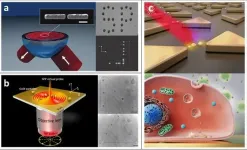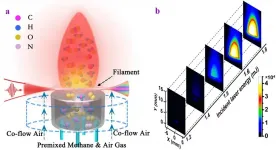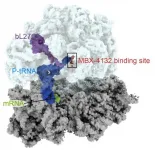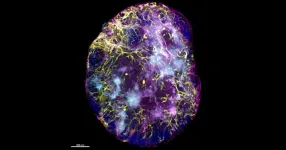INFORMATION:
Plasmonic tweezers: For nanoscale optical trapping and beyond
2021-03-19
(Press-News.org) Optical tweezers and associated manipulation tools in the far field have had a major impact on scientific and engineering research by offering precise manipulation of small objects. More recently, the near-field manipulation with surface plasmons has opened opportunities not feasible with conventional far-field optical methods. The use of surface plasmon techniques enables excitation of hotspots much smaller than the free-space wavelength; with this confinement, the plasmonic field facilitates trapping of various nanostructures and materials with higher precision. It has become commonly used in trapping of micro- and nanometre-sized objects in various fields of science.
In a new review paper published in Light Science & Application, a team of scientists, led by Professor Xiaocong Yuan from Nanophotonics Research Center, Shenzhen University, China, and co-workers have reviewed the principles, developments, and applications of the plasmonic tweezers techniques, including both nanostructure-assisted platforms and structureless systems.
According to excitation situations, surface plasmon can be divided into two types: localized surface plasmon in bounded geometries such as nanoparticles and all-optical excited structureless surface plasmon polaritons on a smooth dielectric-metal interface. Accordingly, the plasmonic tweezers system can be divided into structural type and all-optical modulated type. The structural platform provides an effective approach to trap micro- and nano-scale objects with the advantages of high precision; while the all-optical modulated type is an effective complement for dynamic manipulation and expand the trapping size range to mesoscopic and Mie range. These two kinds of plasmonic tweezers complement each other and have fostered numerous and expanding applications.
Owing to great strides in fundamental science, plasmonic tweezers have been used to manipulate many kinds of matter with various shapes, properties, and compositions. By feat of this technique, small objects can be manipulated dynamically to be sorted and transported for on-chip lithography and fabrications. In particular, biological particles of all sizes are important targets for trapping, and the plasmonic platforms exactly provide stable noninvasive probes for manipulation and detection of them.
Moreover, plasmonic hotspots can be selectively generated as specific traps through the design of structures or modulation of the polarization and phase distribution of excitation laser beams. Such hotspots have the advantages of strong near-field energy, providing the possibility of enhancing spectroscopic measurement of molecules located in the region through techniques such as SERS, infrared absorption, and fluorescence emission spectroscopy. The nanoscale precision of the method enables manipulation and detection at the molecular level, making plasmonic tweezers an important tool for physics, chemists, and life scientists.
"The mechanism and relevant phenomena in nonlinear light-matter interactions, and the intracellular manipulation and detection applications will be the possible development directions and breaking points of the plasmonic tweezers technique in the future." the scientists forecast.
"There are still challenges to be overcome in terms of the inherent properties to extend the applicability of the technique. Regardless, we are confident that the uses of plasmonic tweezer techniques will continue to grow in the near future, and many new applications in this area will be developed. " they added.
ELSE PRESS RELEASES FROM THIS DATE:
Robust and ultralow-energy-threshold ignition of lean fuels by an ultrashort-pulsed laser
2021-03-19
Laser ignition (LI) is a promising electrode-less alternative to electronic spark ignition of lean fuel/air mixtures, offering high thermal efficiency with low harmful emissions. One of the most widely adopted LI methods is nanosecond laser-induced spark ignition (ns-LISI), in which combustible mixtures undergo multiphoton ionization followed by avalanche breakdown, resulting in high-temperature and high-pressure plasma along with shockwaves. However, inevitable shot-to-shot energy fluctuations resulting from ns light sources lead to the stochastic nature of the breakdown, influencing reaction routes and producing potential misfiring.
Although LI is not a new concept, it is commonly deemed that igniting lean-fuel mixtures by an ultrashort femtosecond (fs) ...
High-efficiency pulse compression established on solitons in nonlinear Kerr resonators
2021-03-19
Generating intense ultrashort pulses with high spatial quality has opened up possibilities for ultrafast and strong-field science. It is so important that the Nobel Prize in Physics 2018 was given to Dr. Strickland and Dr. Mourou for inventing a technique called chirped pulse amplification, which drives numerous ultrafast lasers worldwide. With the great advancement in the last decade, Yb-based ultrafast lasers have become highly popular, because they exhibit exceptional thermal efficiency, are low in cost and are highly flexible in adjusting pulse energies and repetition rates. However, the pulse durations from these lasers are usually not shorter than 100 fs or even 1 ps, which requires external ...
New antibiotic clears multi-drug resistant gonorrhea in mice in single dose
2021-03-19
UNIVERSITY PARK, Pa. -- A new antibiotic compound clears infection of multi-drug resistant gonorrhea in mice in a single oral dose, according to a new study led by researchers at Penn State and Emory University. The compound targets a molecular pathway found in bacteria but not humans and could lead to new treatments for gonorrhea and infections from other bacteria, such as tuberculosis and MRSA.
The research team, which also includes scientists from the biopharmaceutical company Microbiotix, the Uniformed Services University, and Florida State, published their results in a paper appearing March 19 ...
Three-dimensional imaging provides valuable insight to immune responses
2021-03-19
A new imaging technique is shining a light on immune responses and setting the scene for enhancing immune memory to optimise vaccine strategies.
By imaging intact lymphoid organs in three dimensions, researchers have been able to identify specialised niches, which can determine how immune T cells function.
The research, published in Nature Immunology, is a step forward in understanding the differentiation of T cells - critical cells for developing strong immune responses - and how we can use these crucial findings to inform and optimise vaccine strategies.
At a glance
Three-dimensional imaging has enabled researchers to identify the factors that play a role in determining where immune memory cells locate ...
Scientists identify genetic pathway that suppresses Lou Gehrig's Disease
2021-03-19
Professor Chunghun Lim and his research team in the Department of Biological Sciences unveiled a neuroprotective pathway that suppresses Lou Gehrig's Disease (ALS).
Nucleocytoplasmic transport (NCT) defects have been implicated in neurodegenerative diseases, such as C9ORF72-associated amyotrophic lateral sclerosis and frontotemporal dementia (C9-ALS/FTD). In this study, the research team has identified a neuroprotective pathway of like-Sm protein 12 (LSM12) and exchange protein directly activated by cyclic AMP 1 (EPAC1) that sustains the nucleocytoplasmic ...
Reactive boride infusion stabilizes ni-rich cathodes for lithium-ion batteries
2021-03-19
A new coating for lithium-ion batteries (LIBs), developed by scientists at UNIST promises extended driving for future electric vehicles (EVs). The coating, described in a paper published in the journal Nature Energy, when applied to LIBs is shown to have improved cycling stability even after being charged and discharged more than 500 times. As a result, the development of EV batteries that can drive longer distances with a single battery charge has gained considerable momentum.
Distinguished Professor Jaephil Cho and his research team in the School of Energy and Chemical Engineering at UNIST unveiled ...
Binge drinking in adolescence is linked to changes in the cerebellum in young adulthood
2021-03-19
Binge drinking in adolescence is associated with changes in the volume of the cerebellum in young adulthood, a new study from the University of Eastern Finland and Kuopio University Hospital shows. Earlier studies have shown that excessive, long-term alcohol consumption causes damage to the cerebellum in adults, but there is very little data on the effects of adolescent drinking on the cerebellum. The findings were published in Alcohol.
The study included 58 young adults aged 21 to 28 years, whose alcohol consumption had been monitored for the previous ten years. Of the participants, 33 had been heavy drinkers since adolescence, while 25 were light drinkers, consuming little or no alcohol at all. All of them were highly functional and had normal ...
How do humpback whales rest?
2021-03-19
An international research collaboration has used an omnidirectional camera attached to humpback whale to reveal how these creatures rest underwater. These findings demonstrate how wide-angle lens cameras can be useful tools for illuminating the ecology of difficult-to-observe animals in detail.
The research group consisted of Assistant Professor Takashi Iwata of Kobe University's Graduate School of Maritime Sciences, Researcher Martin Biuw of the Norwegian Institute of Marine Research, Assistant Professor Kagari Aoki and Professor Katsufumi Sato of the Atmosphere and Ocean Research Institute, the University of Tokyo, and Professor Patrick Miller of the University of St. Andrews.
These research results ...
Endocrine disruptors threatens semen quality
2021-03-19
A growing number of studies show that the environmental factors and lifestyle habits of pregnant women play an important role in the health of their child. But how about the semen quality of young men? Researchers at the University of Geneva (UNIGE), Switzerland, showed two years ago that only 38% of Swiss men had semne parameters above the thresholds set by the World Health Organisation (WHO) for fertile men. Epidemiologists from the Institut de recherche en santé, environnement et travail (IRSET, Rennes, France), in collaboration with the UNIGE team analyzed the potential impact of endocrine disruptors on semen quality of men whose mothers were working at the early ...
Hidden genetic defects contain real risks for serious diseases
2021-03-19
For the first time researchers from Hebrew University of Jerusalem, Radboudumc, Maastricht UMC+ and international colleagues have gained insight into the "hidden genetic defects" of the general European population. This is important because these defects, if inherited from both father and mother, can lead to all kinds of illnesses in their children. Research in the Dutch and Estonian population shows that every person has two to four such hidden genetic defects. In 1 in 100 couples, this leads to a situation with an increased risk of a genetic disease for future children. In the case of consanguinity, even 20 percent of the couples appear to be at high risk. This research is published in The American Journal of Human Genetics and Genetics in Medicine.
The genes of a every ...









